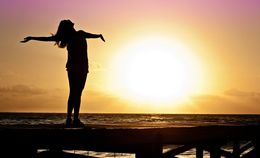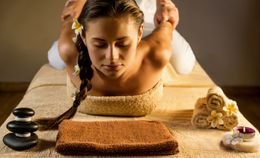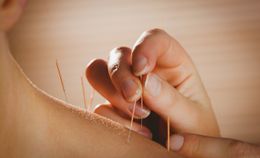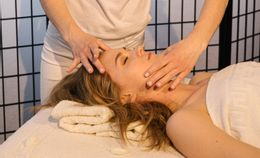If you or a loved one, especially a child, is living with symptoms of ADD/ADHD; chances are you are getting calls from teachers and administrators about behavior in class. Or you may have to help your child through emotional struggles that come with trying to learn in school or complete homework as a child with ADD/ADHD. On the other side of it all, there are also many adults who have to work at managing the symptoms of ADD/ADHD as they also work at finding success in life and in their career.
There are many alternative and natural therapies that are used by parents of children with ADD/ADHD and adults alike - from hypnotherapy to acupuncture there are many options outside of the traditional medications often used to help. But what about craniosacral therapy?
Craniosacral Therapy for ADD/ADHD
Craniosacral therapy can be a useful therapy for managing a person's level of ADD/ADHD symptoms. Being a form of massage, we are going to be looking at two different types of research on the topic in order to gain an understanding of how ADD/ADHD can be impacted by craniosacral therapy:
-
Research study: There are many types of massage, including craniosacral therapy what has been found in regard to the effects of craniosacral therapy and other forms of massage on ADD/ADHD?
-
Case study: A three-and-a-half-year-old with ADD receives craniosacral therapy "was it help helpful"
How Craniosacral Therapy can Work for ADD/ADHD
Craniosacral therapy can be very effective in helping to manage the symptoms of both ADD and ADHD. According to this one study, this form of touch and massage therapy looks for slight changes in the cerebrospinal fluid. This is a fluid that is found to be around the brain and the spinal cord. This fluid when it does not have any blockages, has a particular rhythm, flow, and beat. Craniosacral therapy aims to work at releasing any blockages that occur. It is also a therapy that helps realign even the smallest changes in bone structure in the skull.
8 Ways Craniosacral Therapy can be Helpful for ADD/ADHD
The effect of craniosacral therapy and other massage therapies on children and adults with ADD/ADHD was studied through this one study:
-
Anger: The level of anger can experience a drop.
-
Mood: The level of a person's mood can experience a level of regulation.
-
Sleep: The level of restful sleep increased.
-
Focus: The level of Concentration and focus increased.
-
Relaxation: The level of feelings of comfort and relaxation increased.
-
Connection: Parents and children reported a deeper level of connection.
-
Coping: Transitions and stressful situations can be present throughout the day, the ability to cope increased.
-
Flexibility: Levels of being flexibility increased.
A Case Study and Craniosacral Therapy
What would you do if you had a child who joined your family through adoption or birth and was having the following challenges?
-
Missed developmental milestones
-
Quick to experience frustration
-
An inability to see tasks through to the end
-
Easily distracted
-
Identified as very active
-
Experienced challenges sleeping
-
Avoidance of touch
-
Challenges with digestion
-
Challenges with toileting and self-care
-
Diagnosis of ADD
Those are ten things that the parents of this three-and-a-half-year-old were experiencing. Craniosacral therapy was recommended by the chid's occupational therapist.
Evaluation
The practitioner in the case study concluded with the following eight findings at the end of their evaluation process:
-
Dural tube restrictions: T 11 - L 5
-
Craniosacral rhythm: Diminished and shallow
-
Occipital cranial base: Compressed
-
Frontal bone: Compressed
-
Right temporal bone: Restricted
-
Sacral restriction: Found with fascia 1 shear in both lower extremities.
-
Respiratory diaphragm: Restricted with decreased mobility in the intestinal area of the abdomen.
-
Trust and touch issues: The child showed a level of intolerance to being touched especially at the occipital cranial base.
Treatment
After considering the findings in the evaluation, and the diagnosis of ADD, the practitioner created and formulated a treatment plan for the child. The treatment plan included a combination of touch and massage therapies:
-
Craniosacral therapy
-
Myofascial therapy
-
Somato-Emotional Release (SER)
This treatment combination of different treatment types and therapies in an action plan for treatment is not uncommon. Why? Because craniosacral therapy is a type of massage and touch therapy is often practiced by practitioners who branch out and learn multiple forms of touch and massage therapies.
As the child received treatment, the areas that were identified in the evaluation, experienced the following changes in the course of treatment:
7 Changes that Occurred From Treatment
Here is a list of seven ways treatment for the child resulted in changes that the child recieved the treatment for the aspects identified in the evaluation process:
-
Dural tube restrictions: Cleared
-
Craniosacral rhythm: Improved and balanced.
-
Occipital cranial base: Released and no longer compressed.
-
Frontal bone: Released and no longer compressed.
-
Right temporal bone: Released and no longer compressed.
-
Respiratory diaphragm: Mobility in the intestinal respiratory area of the abdomen was increased.
-
Trust and touch issues: The child showed an increased level of tolerance to being touched.
7 Behavioral Differences Craniosacral Therapy for ADD/ADHD
From the case study, the following behavior changes were witnessed by the parents of the child with ADD:
-
Sleeping patterns: Improved dramatically.
-
Frustration: Levels of frustration was reduced.
-
Tolerance: Levels of tolerance for completing and seeing tasks through increased.
-
Bowel elimination: Became regular.
-
Stomach issues: Disappeared
-
Development milestones: Were easily met and stopped being an issue.
-
Physical contact: Touch, affection, and physical contact became easier for the child.
Craniosacral Effective for ADD/ADHD?
Between the eight ways craniosacral therapy and the changes that the child with ADD experienced from treatment. Craniosacral therapy can be very effective for ADD/ADHD. The symptoms of ADD/ADHD can be helped through craniosacral therapy treatment sessions.
How Many Sessions Will I Need?
When it comes to craniosacral therapy and ADD/ADHD the number of sessions you will need to will vary. The best way to get a good grasp of the number of sessions you will personally need is to talk to your provider. That being said, here is a list to give you an idea of what you may experience when treating ADD/ADHD with craniosacral therapy:
-
1 session: You will most likely experience some change and or improvement with a single session. Some may only need one session for the changes and improvements they are seeking for their ADD/ADHD.
-
3-10 Sessions: On average the number of sessions that may be suggested by your practitioner is three to ten weekly sessions.
-
More sessions: You may find that you personally need more than ten weekly sessions based on the severity of ADD/ADHD symptoms and the symptom management goals that you have set.
-
Maintenance sessions: Once you have reached the level of progress and change that was set with your practitioner and yourself when you were being evaluated and a treatment plan was being treated - going in for a session every two weeks or once a month may be useful to maintain what has been gained.
What will it Cost?
The cost of craniosacral therapy for ADD/ADHD will depend greatly on a few different factors:
-
Location: Depending on where you live, costs will be different. If you live in metropolitan cities like New York City, you can expect to pay more than if you live in an urban town.
-
Discounts: Many practitioners offer discounts that can range from the teacher, senior, student, child, and other discounts.
-
Packages: Some practitioners offer packages. Buying a set number of sessions ahead of time can lead to savings and differences in cost.
-
Practitioner: Each practitioner has a different level of experience and level of training. The range of training and experience a craniosacral therapist has can impact the cost per of sessions that they charge.
-
Sessions: The number of sessions you decide on needing for your treatment plan with your practitioner. The more sessions you have the more you can expect your overall expense to be. Of course, pages and discounts could help with this.
The average price per session in the country is $70-$170. Based on this rate information, if you end of receiving the average three-to-ten sessions, you can expect to pay $700 on the low end and $1,700 on the high end. As you read above though, asking a practitioner about packages and discounts can lead to a different level of financial cost. For more information, read: How Much Does Craniosacral Therapy Cost?
References:
Maddigan, B., Hodgson, P., Heath, S., Dick, B., St John, K., McWilliam-Burton, T., Snelgrove, C., ... White, H. (2003). The effects of massage therapy & exercise therapy on children/adolescents with attention deficit hyperactivity disorder. The Canadian child and adolescent psychiatry review = La revue canadienne de psychiatrie de l'enfant et del'adolescent, 12(2), 40-3. Retrieved March 18, 2019, from https://www.ncbi.nlm.nih.gov/pmc/articles/PMC2538473/
Mann, J., Faurot, K., Wilkinson, L., Curtis, P., Coeytaux, R., Suchindran, C., Gaylord, S. (2008). Craniosacral Therapy for migraine: Protocol development for an exploratory controlled clinical trial. https://www.ncbi.nlm.nih.gov/pmc/articles/PMC2442042/
Strack, C. (n.d.). ADD Child and CranioSacral Therapy - IAHE. Retrieved March 18, 2019, from https://www.iahe.com/docs/articles/ADD_Child_and_CranioSacral_Therapy.pdf















